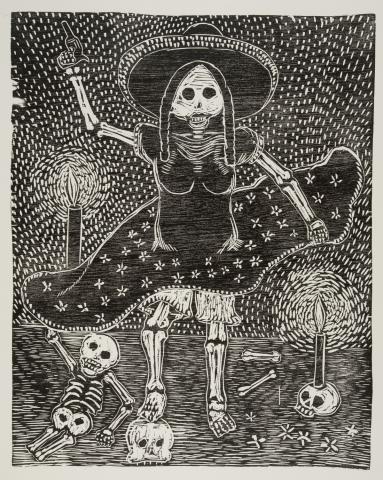
Donated to the JSMA collection by three University of Oregon faculty members, the prints will be on view through April 27, 2014
EUGENE, Ore. -- (February 25, 2014) – The Jordan Schnitzer Museum of Art displays ten woodblock prints from the Assembly of Revolutionary Artists of Oaxaca (ASARO—Asamblea de Artistas Revolucionarios de Oaxaca), that critique the violence of the Mexican government in the 2006 uprising, demand equal rights for disenfranchised groups like farm workers, indigenous peoples, and women, and expose the hypocrisy of the ruling elite. On view through April 27, the works on display were selected by JSMA executive director Jill Hartz and assistant curator June Black and purchased with funds provided by three University of Oregon faculty members, Alice Evans, Center for the Study of Women in Society, Gabriela Martínez, School of Journalism and Communication/Center for the Study of Women in Society, and Lynn Stephen, Department of Anthropology/Center for Latino, Latina, and Latin American Studies.
ASARO was born in the wake of the 2006 uprisings in Oaxaca, Mexico; this year marks the eighth anniversary of the collective’s commitment to engendering social change through art. Located in the heart of Oaxaca on the Calle Porfirio Díaz, the studios of ASARO artists are filled with prints, from heroic portraits of agrarian leader Emiliano Zapato to punk rock renditions of artist Frida Kahlo, that connect to the strong tradition of political art production in Mexico.
On Wednesday, March 5, at 2 p.m., César Chávez Victoria, an artist and member of ASARO, will discuss the founding of the group and its role in the 2006 Oaxaca Rebellion.
“Most printmakers sign each of their prints and produce only a limited run,” says Black, assistant curator for the art of the Americas and Europe. “The artists of ASARO print images as needed from the blocks they keep archived in their studio. They do not sign or edition their works, nor are individual artists credited; rather, they forgo personal recognition in the belief that the voice of the collective can affect social change. “
Annually, in Oaxaca, Mexico, teachers gather for a plantón, or sit-in occupation of the city center, in the hopes of increasing both teacher salaries and school budgets, as well as securing better schools and learning conditions for children. Historically, these peaceful protests are resolved through negotiation, but in the summer of 2006, Governor Ulises Ruiz Ortiz deployed more than 1,000 police to break up the occupation. When the police failed to stop the protest, many uninvolved citizens were wounded and tear-gassed. In the days that followed, the teachers were joined by hundreds of civic and social organizations, unions, farm workers, indigenous groups, and students to form the Popular Assembly of the Peoples of Oaxaca or APPO (Asamblea Popular de los Pueblos de Oaxaca).
The APPO and other organizations led a social movement, which prevented the government from functioning in the state capital for six months and organized new forms of governance, culture, media, and political participation. The movement was shut down when federal police occupied the city in November of 2006, but important parts of the movement live on—particularly as seen in cultural expression.
In the fall of 2006, art students, who contributed to the social movement by creating banners for teachers to use in strikes and marches, formalized their efforts and became the Asamblea de Artistas Revolucionarios de Oaxaca or ASARO. Today, that same group of individuals, in addition to others who have since joined their ranks, continue producing political art and expanding its reach through galleries, museums, schools and stores in Mexico, the United States and Europe.
The exhibition is presented in conjunction with the launch of Lynn Stephen’s new book “We are the Face of Oaxaca: Testimony and Social Movements,” a chapter of which is dedicated to ASARO. The works also support Stephen’s winter term course “Race, Gender, and Political Economy in Latin America.”
About the Jordan Schnitzer Museum of Art
The University of Oregon's Jordan Schnitzer Museum of Art is a premier Pacific Northwest museum for exhibitions and collections of historic and contemporary art based in a major university setting. The mission of the museum is to enhance the University of Oregon’s academic mission and to further the appreciation and enjoyment of the visual arts for the general public. The JSMA features significant collections galleries devoted to art from China, Japan, Korea, America, Europe and elsewhere as well as changing special exhibition galleries. The JSMA is one of six museums in the state of Oregon—and the only university museum--accredited by the American Alliance of Museums.
The Jordan Schnitzer Museum of Art is located on the University of Oregon campus at 1430 Johnson Lane. Museum hours are 11 a.m. to 8 p.m. Wednesdays, and 11 a.m. to 5 p.m. Tuesdays and Thursdays through Sundays. Admission is $5 for adults and $3 for senior citizens. Free admission is given to ages 18 and under, JSMA members, college students with ID, and University of Oregon faculty, staff and students. For information, contact the JSMA, 541-346-3027.
About the University of Oregon
The University of Oregon is among the 108 institutions chosen from 4,633 U.S. universities for top-tier designation of "Very High Research Activity" in the 2010 Carnegie Classification of Institutions of Higher Education. The UO also is one of two Pacific Northwest members of the Association of American Universities.
Contacts Debbie Williamson Smith, Communications Manager, 541-346-0942, debbiews@uoregon.edu
Links: Jordan Schnitzer Museum of Art, http://jsma.uoregon.edu
- Log in to post comments





